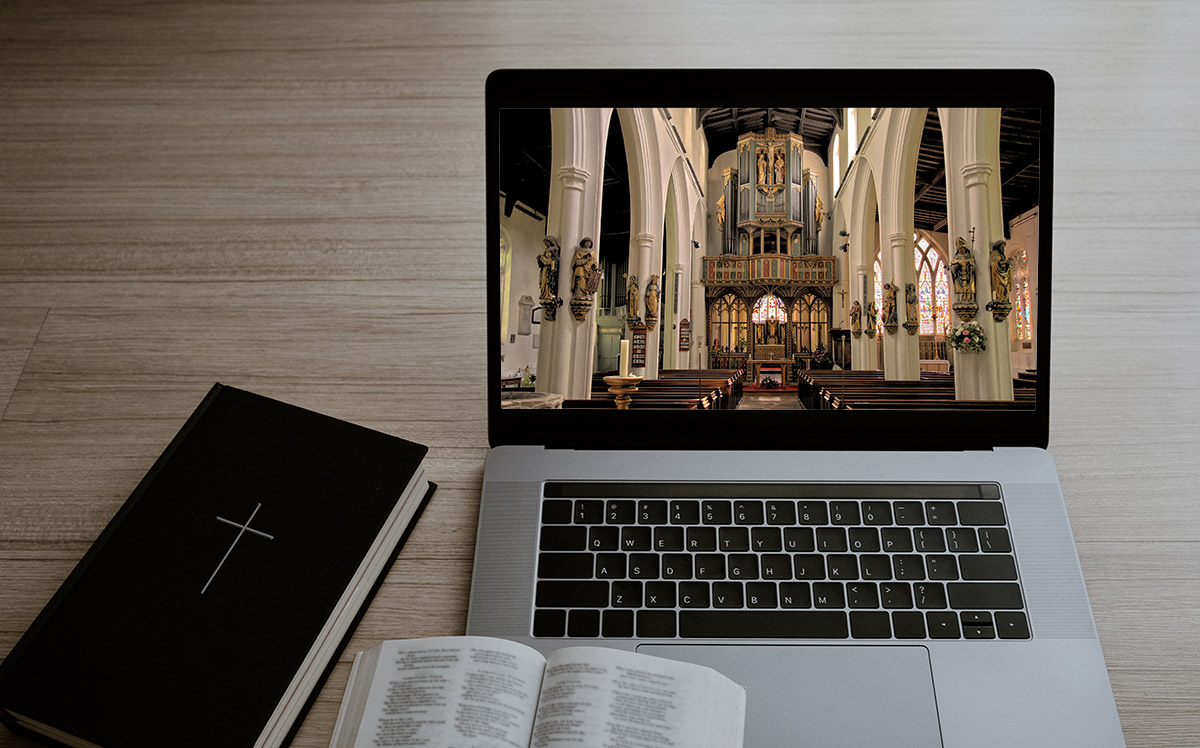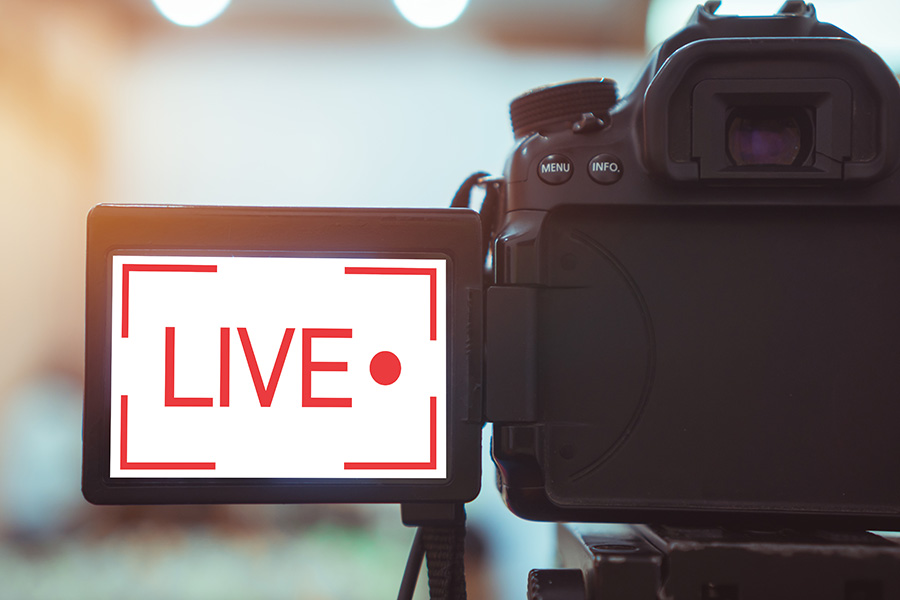A Guide to Live Streaming Church Services
Posted by Nick Yeandle on 30/09/2020

There are many reasons why Churches would want to live stream services. With current restrictions in place on the total number of people permitted in the congregation, live streaming can offer a way for your Church to expand its reach and allow more people to participate. But remember, if the audio and video quality isn't there, it is all too easy to lose your audience. We have therefore put this guide to live streaming together in order to highlight the most important requirements and considerations when setting up a live stream from your Church.
As specialists in live streaming services (both rental and sales), we have found ourselves setting up many live streams in Churches over recent months, providing system rentals and AV technicians for Weddings and Funeral services, as well as permanent installations of live streaming systems for the Sunday Service.
Requirements for Live Streaming
1. Reliable Internet Connection
A broadband connection will be needed for your stream to work - if your Church already has an internet connection then this is obviously a bonus, but if not this will need to be installed. In some more rural areas where fibre-optic broadband is hard to come by, it may still be possible to get an internet connection using a 4G router.
AV Xpert can assist with the installation of WiFi access points and network equipment if needed, offering both permanent installations and rental of temporary networking systems.
You will also need to consider the internet speed (bandwidth) required for live streaming. This depends upon the resolution that you wish to stream at. The most basic stream in standard definition would need as little as 3 Mbps, whilst an HD stream will require around 5 Mbps and a UHD 4K stream can demand as much as 25 Mbps. It is always wise to allow additional headroom to ensure a seamless stream, so generally it is advisable to multiply the minimum requirement by 1.5 to get a connection speed that will be suitable for your stream without dropouts. Note that it is the Upload Speed that we are concerned about. You can check this using an online broadband speed test.

2. Good Quality Camera
Choosing the best camera for your Church can be a little tricky. There are so many different options available ranging from the cheapest sub £100 webcams to 4K PTZ cameras that can cost several thousand pounds.
We recommend you choose a camera based on the size of your Church, and the level of detail that you want to capture from the service. In most cases, either a fixed 4K camera or a 1080p Pan, Tilt, Zoom camera, placed at the back of the Church will be best. If you are planning on using the system with a pan, tilt, zoom (PTZ) camera then you might also want to consider having a dedicated operator to adjust the camera during the stream. You can set presets on more advanced cameras for position and zoom, which can be called by the press of a button from a remote control, or if you are having a dedicated operator, then potentially from a more advanced control system with joystick etc.
A digital SLR camera is always an option too, and most modern DSLRs come with software that enable them to be used as a webcam via USB cable. For older DSLRs though, you would need to use an HDMI output and then connect to a USB capture card.
3. Microphones and Audio System
In order to achieve a broadcast-quality audio feed for the stream it is essential to use good quality external microphones, and if possible, you should also take an audio feed from your existing PA system. Do not rely upon built-in microphones from a laptop, webcam or camcorder, as these will not pick up sound clearly and will result in a muffled sound track and often with a lot of hiss or hum.
We recommend a basic 2-channel or 4-channel audio interface with at least 1 boundary microphone for picking up general ambient sound (organ, instruments etc.) , and either 1 shotgun microphone or if possible, an audio feed from your PA system for picking up speech.
Don't forget about the levels! If using YouTube as the streaming platform, your audio levels will be automatically adjusted to try and keep them consistent, however it is always best to monitor the levels and adjust them throughout the service to account for different volumes from the service, whether this be different people speaking, or from a loud organ or ensemble.
4. A PC, Laptop or Encoder to Drive the System
The system needs to be driven by some form of computer. The simplest option would usually be a laptop with a direct connection to your preferred streaming platform. You would plug in the audio interface and camera to the laptop and then operate everything from the web browser.
For the more advanced or more ambitious user, there is also some good software available, some free to use, such as OBS. These software packages integrate with the major streaming services, and allow you to improve the stream by adding titles, overlays and effects amongst other things, which can help improve the stream and create a more professional look to your broadcast.
Minimum recommended system requirements would be an Intel i5 dual-core processor @ 2.3 GHz (or equivalent) and 8 GB of RAM.
If you don't want to go down the PC route, there are also purpose designed Recorders and Encoders available on the market that can provide a more robust and easier-to-use solution. A purpose-built device like this would be preconfigured with the details and credentials of the streaming platform, enabling the stream to go live and be paused at the touch of a button. This would make the system easier to operate for the less technically minded user. Other advantages of such product are that they can also provide a local recording of the service directly to a USB stick, USB hard drive or SD card, so if your stream were to lose quality as a result of a temporary drop in internet connection, you would still have a full-quality recording of the service on the device itself. Finally you can also connect a wider variety of cameras to this type of device, so for example if you already have a camcorder or video camera with HDMI or SDI output, this can be used directly with a recorder and encoder. If you were to use a laptop or PC, you would need to have a USB compatible camera, or an expensive capture card for external video inputs.
Broadcasting the Stream
There are a number of free platforms that allow live streaming, the most popular by far being Facebook and YouTube. We recommend YouTube as it provides a very stable platform and the quality tends to be consistently reliable.
People can tune in to the stream directly from your YouTube channel or from a link to the stream, or alternatively AV Xpert can assist with the embedding of your feed in to your own website.
Choosing the Right System for Your Church - Balancing Performance with Budget
The costs for streaming equipment can be quite varied. If you are budget conscious, then above all else, we recommend that you invest in a good quality audio feed initially, as without broadcast-quality audio, people will not be able to properly engage with the service. High definition video with the ability to zoom in and pan and tilt the camera would then be the next area to invest in.
If you need help or advice, or would like a quote for the installation of a fixed streaming system, or for the rental of a temporary system for a one-off service, get in touch with us today. We will be happy to answer any of your questions, and can provide a no-obligation site visit and free system design and quotation. Call us on 01480 587556, or email info@avxpert.co.uk.

